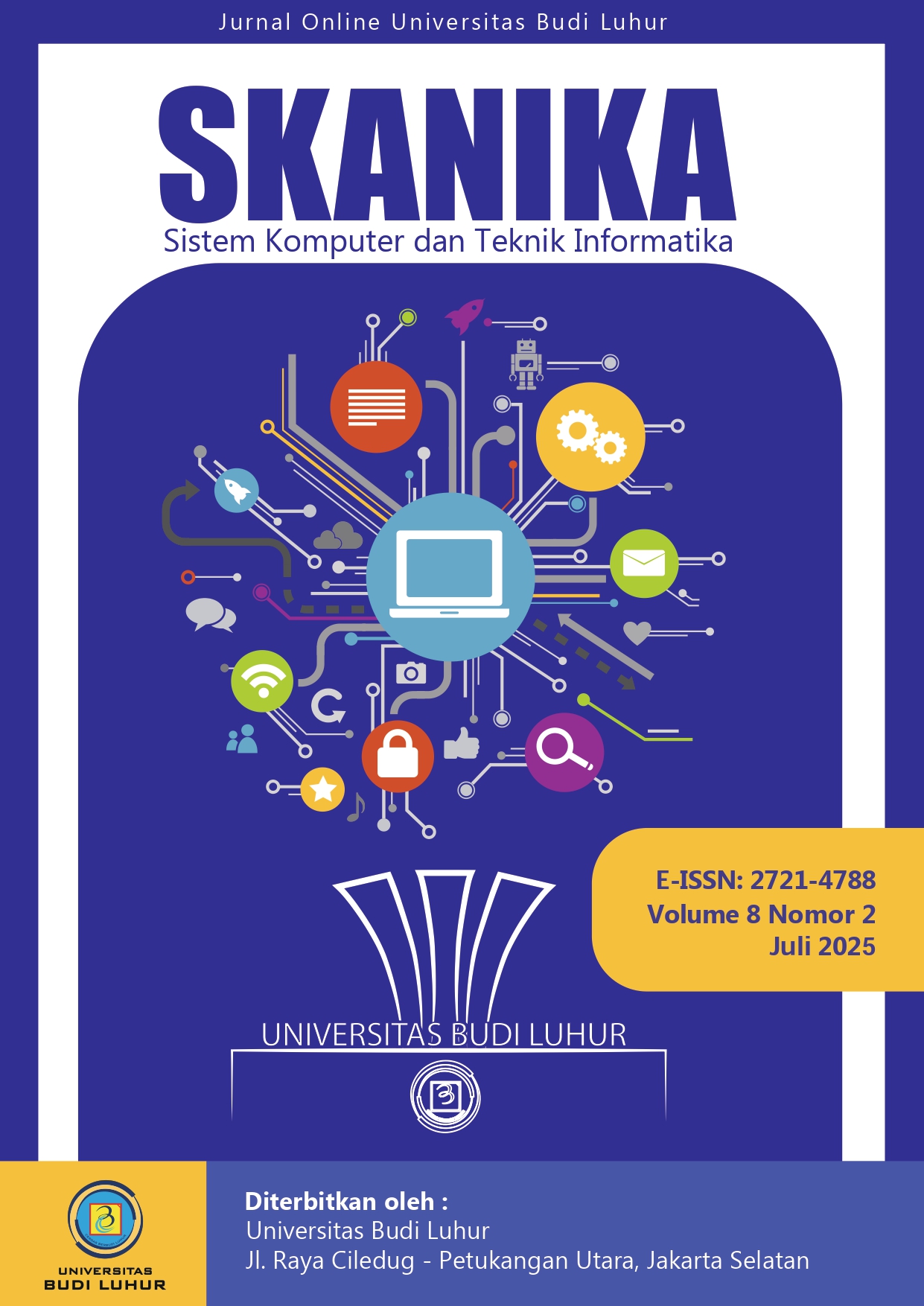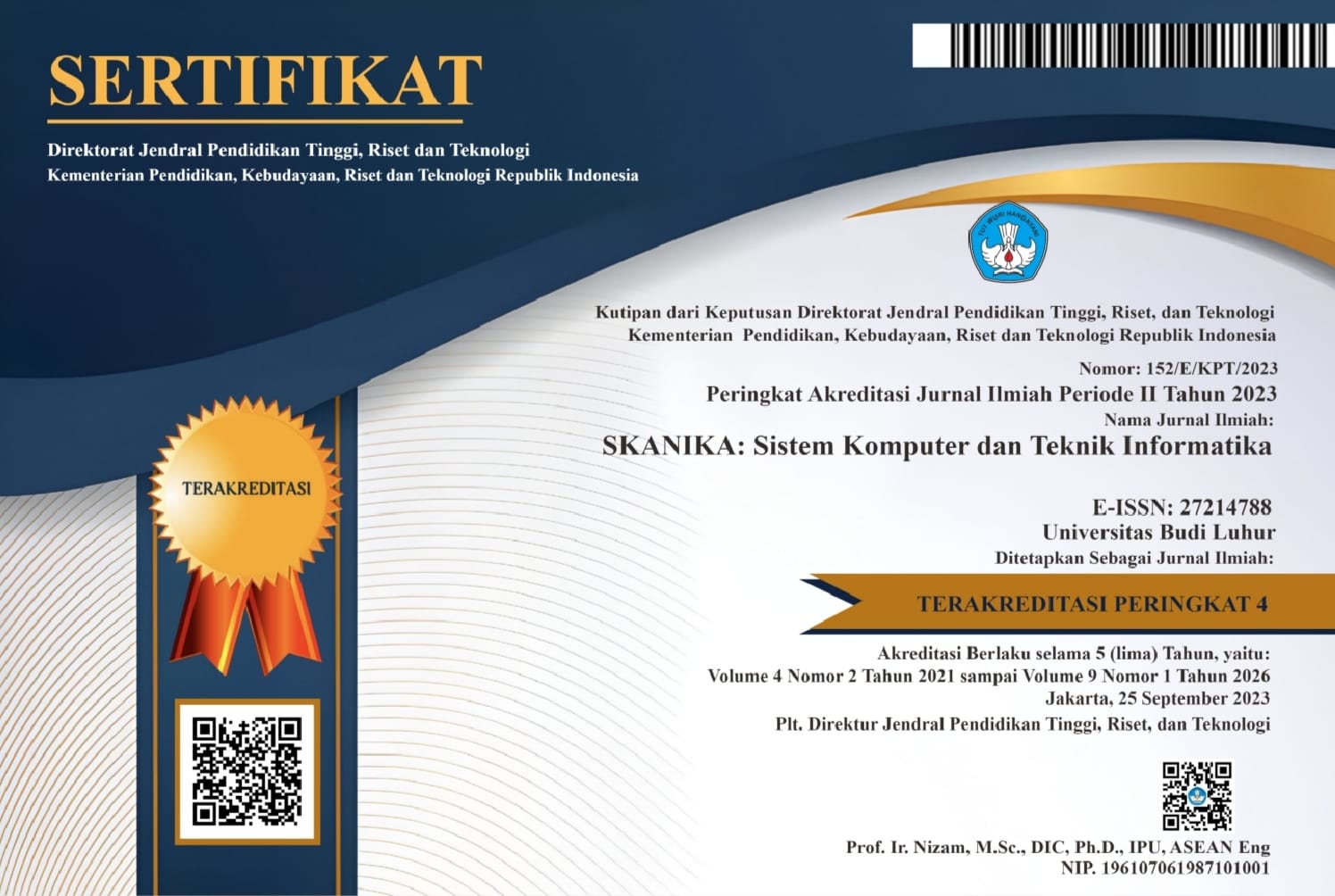SISTEM KEAMANAN RUMAH PINTAR BERBASIS SENSOR ESP32-CAM DAN PIR DENGAN NOTIFIKASI TEKNOLOGI BOT WHATSAPP
DOI:
https://doi.org/10.36080/skanika.v8i2.3387Keywords:
ESP32-Cam, PIR Sensor, Smart Home, Internet of Things, WhatsappAbstract
A smart home is a system that basically consists of intelligent elements that are interconnected and integrated with each other through the use of internet networks based on the Internet of Things. Today, smart home technology has been utilised in various rooms in contemporary homes. Several components, such as the ESP32-Cam microcontroller, of these smart home devices are installed in the room and include a motion sensor or PIR (Passive Infrared Receiver), buzzer, and WhatsApp notification software. When motion or activity is detected in the room, the components connected and integrated with the internet network will send notifications to a laptop or WhatsApp messaging programme in the form of text and photos. The results of tool testing and overall system testing data show that the PIR sensor can detect motion at a distance of 1 to 3 metres marked by the activation of the buzzer and the appearance of WhatsApp messages with an average delay of 1 to 3 seconds. Experiments were also carried out based on the length of the 5-pin USB cable, and the results showed that the length of the cable affected the delay in sending WhatsApp notifications in addition to wifi or internet connection. WhatsApp notifications take longer to send the longer the cable is. By using this smart home appliance, home dependability and security can be improved.
Keywords: ESP32-Cam, PIR Sensor, Smart Home, Whatsapp
Downloads
References
[1] A. H. Bachtiar, P. P. Surya, and R. P. Astutik, “Rancang Bangun Dual Keamanan Sistem Wajah Dan Sidik Jari Berbasis Iot ( Internet of Things ),” Jurnal POLEKTRO, vol. 11, no. 1, pp. 102–107, 2022.
[2] A. Fakhruddin, and D. Irawan, “Rancang Bangun Sistem Keamanan Pintu Rumah Berbasis Internet of Things Dengan Esp32 Dan Aplikasi Blynk,” Jurnal Teknik Elektro dan Informatika, vol. 19, no. 1, p. 53, 2024, doi: 10.30587/e-link.v19i1.7600.
[3] O. Taiwo and A. E. Ezugwu, “Internet of Things-Based Intelligent Smart Home Control System,” Security and Communication Networks, vol. 2021, pp. 1-17, 2021, doi: https://doi.org/10.1155/2021/9928254.
[4] H. M. Syaban, T. Mufizar, and R. Ruuhwan, “Rancang Bangun Alat Keamanan Rumah Menggunakan Sensor Pir Dengan Notifikasi Telegram Berbasis Iot Dan Catu Daya PLTS,” Jurnal Informatika dan Teknik Elektro Terapan, vol. 12, no. 2, pp. 1080-1089, 2024, doi: https://doi.org/10.23960/jitet.v12i2.4126.
[5] R. B. Salikhov, V. K. Abdrakhmanov, and I. N. Safargalin, “Internet of things (IoT) security alarms on ESP32-CAM,” Journal of Physics: Conference Series, vol. 2096, no. 1, 2021, pp. 1-7, doi: 10.1088/1742-6596/2096/1/012109.
[6] A. K. Sikder et al., “A Survey on Sensor-Based Threats and Attacks to Smart Devices and Applications,” IEEE Communications Surveys & Tutorials, vol. 23, no. 2, pp. 1-35, 2021, doi: 10.1109/COMST.2021.3064507.
[7] N. A. Khan, A. Awang, and S. A. A. Karim, “Security in Internet of Things: A Review,” IEEE Access, vol. 10, pp. 104649–104670, 2022, doi: 10.1109/ACCESS.2022.3209355.
[8] A. S. Fadillah and P. Purwanto, “Prototipe Keamanan Rumah Menggunakan ESP32 Cam dan Sensor PIR Berbasis Android,” Seminar Nasional Mahasiswa Fakultas Teknologi Informasi, vol. 1, no. 1, pp. 1129–1136, 2022.
[9] X. Li et al., “Smart Applications in Edge Computing: Overview on Authentication and Data Security,” IEEE Internet of Things Journal, vol. 8, no. 6, pp. 4063–4080, 2021, doi: 10.1109/JIOT.2020.3019297.
[10] J. Yang and L. Sun, “A Comprehensive Survey of Security Issues of Smart Home System: ‘Spear’ and ‘Shields,’ Theory and Practice,” IEEE Access, vol. 10, no. November, pp. 124167–124192, 2022, doi: 10.1109/ACCESS.2022.3224806.
[11] H. Raeis, M. Kazemi, and S. Shirmohammadi, “Human Activity Recognition with Device-Free Sensors for Well-Being Assessment in Smart Homes,” IEEE Instrum. Meas. Mag., vol. 24, no. 6, pp. 46–57, 2021, doi: 10.1109/MIM.2021.9513637.
[12] V. Roviqoh, A. Damayanti, and I. P. Wardhani, “Sistem Human Computer Interaction (HCI) Keamanan Rumah Pintar Berbasis IoT,” Jurnal Ilmu Komputer dan Informatika, vol. 3, no. 1, pp. 65–72, 2023, doi: 10.54082/jiki.29.
[13] F. Fitri et al., “Implementasi Sistem Keamanan IoT Berbasis QR Code pada Loker untuk Peningkatan Keamanan dan Aksesibilitas,” J. Elektron. dan Otomasi Ind., vol. 11, no. 3, pp. 788–796, 2024, doi: 10.33795/elkolind.v11i3.6650.
[14] R. Septian and S. . Prasetiyo, “Sistem Keamanan Menggunakan Kamera dan Sensor Gerak Berbasiskan Internet of Things (IoT),” Jurnal Ilmu Komputer dan Sains, vol. 1, no. 09, pp. 1330–1339, 2022.
[15] P. W. Rusimamto et al., “Implementation of arduino pro mini and ESP32 cam for temperature monitoring on automatic thermogun IoT-based,” Indonesian Journal of Electrical Engineering and Computer Science, vol. 23, no. 3, pp. 1366–1375, 2021, doi: 10.11591/ijeecs.v23.i3.pp1366-1375.
[16] S. O. N. Putri et al., “Sistem Keamanan Rumah Berbasis Iot Dengan Nodemcu Esp8266 Menggunakan Sensor Pir Sebagai Pendeteksi Gerakan,” Jurnal Informatika Komputer Bisnis dan Manajemen, vol. 20, no. 2, pp. 13–22, 2022, doi: 10.61805/fahma.v20i2.29.
[17] M. K. Ario et al, “Designing IoT-Based Smarthome System With Chatbot,” Engineering Mathematics and Computer Science (EMACS) Journal, vol. 4, no. 3, pp. 113–117, 2022, doi: 10.21512/emacsjournal.v4i3.8787.
Downloads
Published
How to Cite
Issue
Section
License
Copyright (c) 2025 Hayadi Hamuda, Anjar Setiawan

This work is licensed under a Creative Commons Attribution-ShareAlike 4.0 International License.
CC BY-SA 4.0
Creative Commons Attribution-ShareAlike 4.0 International
This license requires that reusers give credit to the creator. It allows reusers to distribute, remix, adapt, and build upon the material in any medium or format, even for commercial purposes. If others remix, adapt, or build upon the material, they must license the modified material under identical terms.
BY: Credit must be given to you, the creator.
SA: Adaptations must be shared under the same terms.ng












